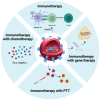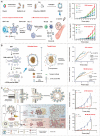Bacterial extracellular vesicles-based therapeutic strategies for bone and soft tissue tumors therapy
- PMID: 36185613
- PMCID: PMC9516228
- DOI: 10.7150/thno.78034
Bacterial extracellular vesicles-based therapeutic strategies for bone and soft tissue tumors therapy
Abstract
Bone and soft tissue tumors are complex mesenchymal neoplasms that seriously endanger human health. Over the past decade, the relationship between microorganisms and human health and diseases is getting more attention. The extracellular vesicles derived from bacteria have been shown to regulate bacterial-host cell communication by transferring their contents, including nucleic acids, proteins, metabolites, lipopolysaccharides, and peptidoglycans. Bacteria extracellular vesicles (BEVs) are promising lipid-bilayer nanocarriers for the treatment of many diseases due to their low toxicity, drug loading capacity, ease of modification and industrialization. Specially, BEVs-based cancer therapy has attracted much attention because of their ability to effectively stimulate immune responses. In this review, we provide an overview of the biogenesis, composition, isolation, classification, and internalization of BEVs. We then comprehensively summarize the sources of BEVs in cancer therapy and the BEVs-related cancer treatment strategies. We further highlight the great potential of BEVs in bone and soft tissue tumors. Finally, we conclude the major advantages and challenges of BEVs-based cancer therapy. We believe that the comprehensive understanding of BEVs in the field of cancer therapy will generate innovative solutions to bone and soft tissue tumors and achieve clinical applications.
Keywords: Bacteria extracellular vesicles; Bone and soft tissue tumors; Immunotherapy; Nanotechnology; Synergistic therapy.
© The author(s).
Conflict of interest statement
Competing Interests: The authors have declared that no competing interest exists.
Figures










Similar articles
-
Bacterial extracellular vesicles in osteoarthritis: a new bridge of the gut-joint axis.Gut Microbes. 2025 Dec;17(1):2489069. doi: 10.1080/19490976.2025.2489069. Epub 2025 Apr 11. Gut Microbes. 2025. PMID: 40213946 Review.
-
Unveiling clinical applications of bacterial extracellular vesicles as natural nanomaterials in disease diagnosis and therapeutics.Acta Biomater. 2024 May;180:18-45. doi: 10.1016/j.actbio.2024.04.022. Epub 2024 Apr 17. Acta Biomater. 2024. PMID: 38641182 Review.
-
Bacterial extracellular vesicles: Emerging nanoplatforms for biomedical applications.Microb Pathog. 2023 Oct;183:106308. doi: 10.1016/j.micpath.2023.106308. Epub 2023 Aug 16. Microb Pathog. 2023. PMID: 37595812 Review.
-
The emerging role of bacterial extracellular vesicles in human cancers.J Extracell Vesicles. 2024 Oct;13(10):e12521. doi: 10.1002/jev2.12521. J Extracell Vesicles. 2024. PMID: 39377479 Free PMC article. Review.
-
Bacterial extracellular vesicles as bioactive nanocarriers for drug delivery: Advances and perspectives.Bioact Mater. 2021 Dec 17;14:169-181. doi: 10.1016/j.bioactmat.2021.12.006. eCollection 2022 Aug. Bioact Mater. 2021. PMID: 35310361 Free PMC article. Review.
Cited by
-
Exploring the Proteomic Landscape and Immunomodulatory Functions of Edwardsiella piscicida Derived Extracellular Vesicles.J Microbiol Biotechnol. 2024 Dec 17;35:e2410001. doi: 10.4014/jmb.2410.10001. J Microbiol Biotechnol. 2024. PMID: 39849936 Free PMC article.
-
Topical drug delivery strategies for enhancing drug effectiveness by skin barriers, drug delivery systems and individualized dosing.Front Pharmacol. 2024 Jan 16;14:1333986. doi: 10.3389/fphar.2023.1333986. eCollection 2023. Front Pharmacol. 2024. PMID: 38293666 Free PMC article. Review.
-
Silk fibroin-based hydrogels for cartilage organoids in osteoarthritis treatment.Theranostics. 2025 Jan 1;15(2):560-584. doi: 10.7150/thno.103491. eCollection 2025. Theranostics. 2025. PMID: 39744693 Free PMC article. Review.
-
Targeted microbubbles combined with low-power focused ultrasound promote the thrombolysis of acute deep vein thrombosis.Front Bioeng Biotechnol. 2023 Mar 16;11:1163405. doi: 10.3389/fbioe.2023.1163405. eCollection 2023. Front Bioeng Biotechnol. 2023. PMID: 37008026 Free PMC article.
-
Bacterial Extracellular Vesicles in Oncology: Molecular Mechanisms and Future Clinical Applications.Cancers (Basel). 2025 May 26;17(11):1774. doi: 10.3390/cancers17111774. Cancers (Basel). 2025. PMID: 40507254 Free PMC article. Review.
References
-
- Siegel RL, Miller KD, Jemal A. Cancer statistics, 2018. CA Cancer J Clin. 2018;68:7–30. - PubMed
-
- Li X, Seebacher NA, Hornicek FJ, Xiao T, Duan Z. Application of liquid biopsy in bone and soft tissue sarcomas: Present and future. Cancer Lett. 2018;439:66–77. - PubMed
-
- Doyle LA. Sarcoma classification: an update based on the 2013 World Health Organization classification of tumors of soft tissue and bone. Cancer. 2014;120:1763–74. - PubMed
-
- Steffner RJ, Jang ES. Staging of bone and soft-tissue sarcomas. J Am Acad Orthop Surg. 2018;26:e269–e78. - PubMed
-
- Harrison DJ, Geller DS, Gill JD, Lewis VO, Gorlick R. Current and future therapeutic approaches for osteosarcoma. Expert Rev Anticancer Ther. 2018;18:39–50. - PubMed
Publication types
MeSH terms
Substances
LinkOut - more resources
Full Text Sources
Miscellaneous

